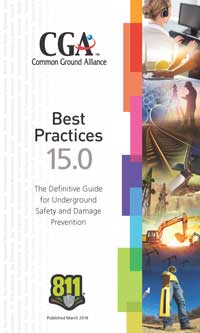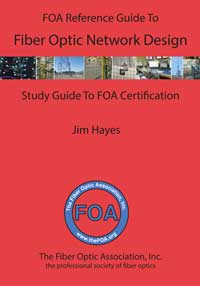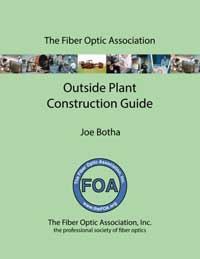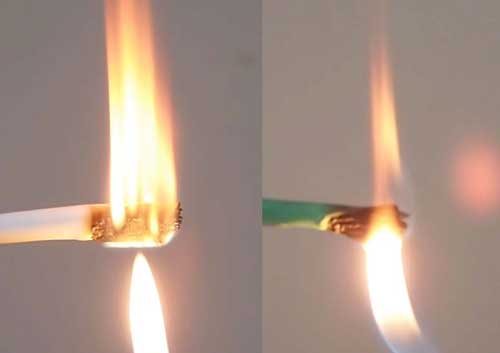The Newsletter Of The Fiber Optic Association (original) (raw)
New: The FOA Fiber FAQs Page (FAQ s = frequently asked questions) gathers up questions readers have asked us and adds tech topics of general interest.
WiFi, DAS or Small Cell?
Nothing provides perspective better than looking at something as an outsider. Especially an outsider who's just trying to understand something instead of an insider trying to perform successfully while being an insider. That's how we feel about wireless communications. If you say "wireless" to an IT or LAN person, they think WiFi. But to a telecom person they think cellular. FOA's involvement is based on trying to understand the infrastructure to support wireless, OSP or premises, WiFi or cellular, tower site or small cell.
We're basically outsiders on the technology looking at the infrastructure to support them. Recently we've been trying to understand the technologies, markets and applications for both to better include the two technologies in our training and certification programs.
The initial question we had dealt with distinguishing DAS (distributed antenna systems for cellular) and small cells (also cellular). In most ways they seem to be very similar, except perhaps DAS is indoors and small cells outdoors.
We've started to interview insiders in both technologies to try to understand how they work and why we should have both. Right off, we found that there appears to be a general lack of technical understanding about the other from almost everybody we talk to who works with one of them. And we're talking real basics - what frequencies are used, protocols, coverage, bandwidth, etc. etc. etc. Even the jargon is different, but that's not unexpected. So we've tried to consolidate information on the three different premises wireless technologies appropriate for general usage. Over time we expect to refine this comparison with more data and user feedback. (got any? send it to us)
Based on the current evaluation, WiFi is essential to premises spaces and because of the ubiquity of WiFi, it is inexpensive. However, WiFi connections for cellular mobile devices appears to have not yet been refined sufficiently to provide reliable coverage for cellular voice, but data is good and video, maybe. Given the cost structure of data plans, using cellular for video can be very expensive but WiFi is preferable since it is only limited by bandwidth.
The choice between small cell and DAS in premises spaces is simple - small cells are generally single carrier connections and that is too limiting for most users. DAS is similar technology but has the advantage of offering multiple service providers. If better cellular service is desired indoors and WiFi connections for cellular calls is unreliable, a DAS is the best solution.
Small cells appear to be a good solution for better cellular service outdoors in metropolitan areas but the capital costs for building systems is quite high - Deloitte, you might remember from an earlier FOA Newsletter, forecast a cost of over $200 billion. It makes one wonder if the carriers can make that investment while simultaneously investing in 5G.
Premises Wireless Comparison
| Premises Wireless | WiFi | DAS (Cellular) | Small Cell (Cellular) |
|---|---|---|---|
| Connects to: | PCs, tablets, phones, many other devices | Phones, tablets, some other devices | Phones, tablets, some other devices |
| Usage | Free, sponsored | Paid | Paid |
| Origin | Private, LAN | Public, telco | Public, telco |
| Frequency Ranges | Unlicensed 2.5GHz (802.11n, 14 - 40MHz channels, 3 max non-overlapping) 5GHz (802.11ac or 802.11n, 24 - 80 MHz channels, 23 max non-overlapping)(more bandwidth, less range) | Licensed 3G: 850, 1700, 1900, 2100 MHz 4G/LTE: 600, 700, 850, 1700, 1900, 2100, 2300, 2500 MHz CBRS (Citizens band Radio Service, shared, unlicensed): 3600 MHz, 20MHz channels, 5G: Eur: 24-27GHz, US: 37-48GHz, 71-74GHz | Licensed 3G: 850, 1700, 1900, 2100 MHz 4G/LTE: 600, 700, 850, 1700, 1900, 2100, 2300, 2500 MHz CBRS (Citizens band Radio Service, shared, unlicensed): 3600 MHz, 20MHz channels, 5G: Eur: 24-27GHz, US: 37-48GHz, 71-74GHz |
| Connects to: | Internet | Multiple telco carriers | Single telco carrier |
| Mobility | Log in to each new private system required, limited handoffs between WiFi systems or WiFi and cellular | Seamless handoffs | Seamless handoffs subject to coverage |
| BYOD (bring your own device) | OK | OK | Depends on service provider device connects to |
| Optimized for | Data | 3G: voice 4G/LTE/5G: data | 3G: voice 4G/LTE/5G: data |
| Data: Max data rate: | 802.11n: ~35-300Mb/s 802.11ac: ~400Mb/s - 7 Gb/s (MIMO) | 4G/LTE: ~100Mb/s 5G: ~Gb/s (proposed) | 4G/LTE: ~100Mb/s 5G: ~Gb/s (proposed) |
| Voice | VoIP: good Cellular on WiFi: not optimal, depends on device/carrier/implementation | Good with proper coverage | Good with proper coverage |
| Video | Good | 4G/LTE: marginal, expensive 5G: Good (proposed), cost? | 4G/LTE: marginal, expensive 5G: Good (proposed), cost? |
| Cabling (typical) | Fiber backbone to Cat 5, POE | Fiber, sometimes Cat 5 | Fiber, sometimes Cat 5 |
| Summary | Best for data on PCs, tablets, smartphones, good for VoIP systems, marginal on cellular devices | Best for cellular devices since can cover all service providers, not optimal for high throughput data (today, future 5G ?) | Good for cellular devices but can cover only one service provider, not optimal for high throughput data (today, future 5G ?) |
Resource For Small, Private FTTH Systems
Phil Trubey worked with his homeowners association to research and develop a FTTH network. In doing this, he researched FTTH thoroughly (including FOA). He's created a website to share what he learned. FTTH.Buildis an informational site for HOAs and small communities on how to build your own Fiber To The Home gigabit Internet network.
This web site is to help Home Owners Associations and other small communities who are looking to build their own fiber optic network to provision gigabit Internet for their residents. It assumes that you are on your own, and no telecom carrier is interested is building out a fiber network for your area. Methods described here are applicable to communities ranging in size from a couple of hundred residents to 20,000 or more residents.
Visit http://ftth.build
FOA Connector Survey
FOA wants to know what connector termination types you are using in your installation work. Please take our survey and provide the information requested so we can tabulate results and report in the FOA Newsletter. For the typical types of connector termination processes, approximately what percentage of your work do they represent?
Write the number in the boxes in the survey form - e.g. 0%, 15%, etc.
We'll leave the survey open for another month or two to get more input.
Results through November, 2018
Prepolished splice: 10%
SOC fusion splice on connectors: 12%
Fusion spliced pigtails: 61%
Adhesive polish: 18%
FOA Master Instructor Retires From Teaching, Helps FOA Members With Websites
Many times in this newsletter, we've run news and comments from FOA Master Instructor Bob Ballard. This year, Bob sold his training company and retired from teaching. That doesn't mean he's sitting back in a rocking chair however. He and his wife bought a farm with a historic house in the Northeast US and he still keeps up with his hobbies like treasure hunting (we're not sure about the hot rods or homebuilt airplanes, though.) FOA will miss Bob and his contributions to the FOA. Bob recently sent us this note about his history with the FOA and what he's doing now.

From Bob: As I look to the past and ponder the toils, tasks, relationships, possibilities, probabilities, and success formulas of building one of the largest fiber optics training companies in the world, I cannot recall an instance where I did not have the assistance of Jim and Karen Hayes. Their incredible knowledge and foresight helped make all things possible.
In the beginning (circa 1999) when I had a few three-ringed binders, some old "twist-on" connectors, a great attitude, and a well-used projector, I presented the idea of fiber education partnerships with community colleges to Jim and Karen. It was not long before we mutually agreed that this would be an excellent idea. Since I was based in Austin, Texas, I mailed a letter along with my proposed "curriculum" to Mr. Bob McGoldrick, Continuing Education Coordinator at Austin Community College, at that time. I was very optimistic about my offer to his campus and confident I would soon hear from him. After three weeks I still had no reply and came to the disappointed conclusion that my proposal to bring fiber optics courses to ACC had fallen on deaf ears.
However, one afternoon about a week later, I received a phone call from Bob saying he had reviewed my materials and would like to meet with me to discuss a partnership. During our meeting, Bob and I talked about the great need for fiber optics technician training in the marketplace. Recognizing that this technology was the media of the future for fiber to the home and long-distance voice, video, and data transmission, we agreed on a mutually beneficial financial package and a proposed schedule. My new company became a reality. At that time, I had no website, very little equipment, and a limited supply of student handouts. Additionally, I was only offering the three-day CFOT course.
The award of the ACC contract prompted me to send out a mailer to 50 or 60 additional campuses that were within one or two days driving distance. After a few weeks, I had not one but five campus partners under contract! I had also created an excellent website to market my company and had gathered the tools and equipment I needed for my growing enterprise. I soon developed more campus partners around the country and, at one time, had 5 contract instructors and 36 campuses under contract. None of this would have been possible without Jim and Karen Hayes of the FOA. As a result of my relationship with them over the past 30 years and the fact that I had outstanding instructors working with me, I was able to build one of the largest and most successful FOA fiber optics training schools in the U.S.
As of August 1, 2018, I sold that company. I am now starting a new company in a different arena--website development. Because of my past business experiences and successes, I realized there was a great need for a high-quality, low-cost website design company. Hence, I created www.econowebsites.org and am offering a 10% discount on products and services to all veterans and FOA-certified technicians. With the continuing assistance of Jim and Karen Hayes, I am confident Econowebsites.Org will further the mission of the FOA and, also, contribute to the success of aspiring entrepreneurs. I trust that out of the thousands of students who attended my classes over the years, I was able to positively impact the lives of at least a few individuals and that I can continue to do so with the help of the FOA.
As a part-time treasure hunter, I am still seeking that elusive hoard of treasure! The banner of photos above has some interesting photos of a few of my recent finds from treasure hunting. The 3rd photo from the left shows coins and artifacts dug up near a Roman village in Milton Keynes, England, which remain in the possession of the very excited landowner. The other photos are of my shark "friends" from a past dive. I call them "friends" because I was not on their menu at the time. Currently, I am working on a house in my area that was built in 1764 in which descendants of the original family are still living. There are numerous structures on the 13-acre tract that even predate the house. I hope to report on that "hunt" in the near future.
Anyone seeking information about my web page services can give me a call at: 717-344-1277 or email me at: bob@econowebsites.org
How Does An FOA School Serve Multiple Locations?
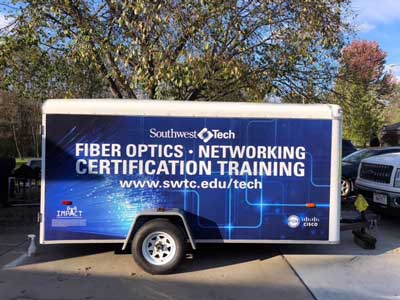
Aaron Holverson, Network Communications Instructor at Southwest Wisconsin Technical College sent us a photo of their trailer used to transport their fiber optic lab between facilities at SWTC. That's a great way to promote the courses in fiber optics and networks offered at SWTC every semester. And thanks to Aaron for the promotion of the FOA with the logo on the trailer.
They've ALL Got It All Wrong
This topic is now covered on the FOA Fiber FAQs Page (FAQ s = frequently asked questions)
Why do so many people think are stripping the cladding from the core when prepping to cleave MM and SM fiber? To FOA, it seems important to understand where this misinformation comes from. We did an image search on the Internet for drawings of optical fiber. Here is what we found:
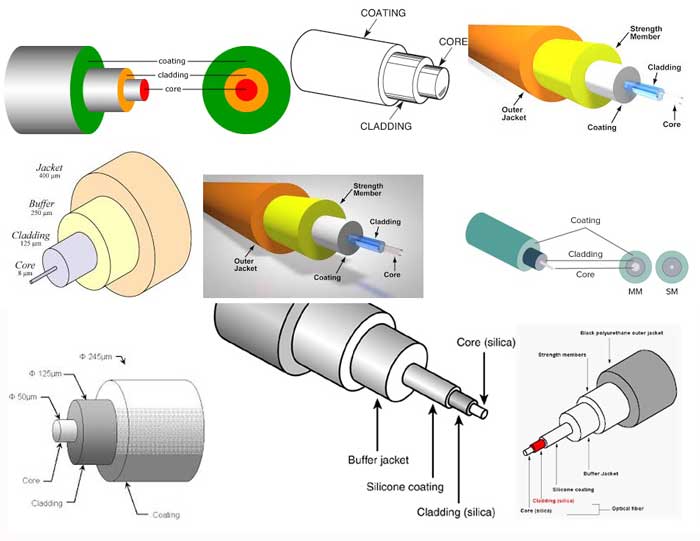
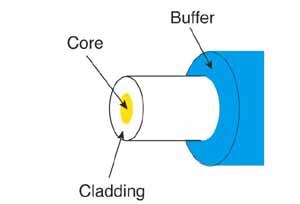
Everybody else (L) and FOA (R)
EVERY fiber drawing we found on the Internet search with one exception (which we will show in a second) showed the same thing - the core of the fiber separate sticking out of the cladding and the cladding sticking out of the primary buffer coating. Those drawings are not all from websites that you might expect some technical inaccuracies, several were from fiber or other fiber optic component manufacturers and one was from a company specializing in highly technical fiber research equipment.
The only drawing we found that does not show the core separate from the cladding was, no surprise, on the FOA Guide page on optical fiber.
Special Request: To everyone in the fiber optic industry who has a website with a drawing on it that shows the core of optical fiber separate from the cladding, can you please change the drawing or at the very least add a few words to tell readers that in glass optical fiber the core and cladding are all part of one strand of glass and when you strip fiber, you strip the primary buffer coating down to the 125 micron OD of the cladding?
TIA Fiber Optic Tech Consortium Has New Website

The TIA FOTC, a group of TIA companies that promote fiber use, has a new website with lots of information on the organization, it's webinars and white papers. It also has a section on member news that includes new products and applications.
https://www.tiafotc.org
New Section Of The FOA Guide - ****The FOA Guide to OSP Construction**
For most certifications, the FOA has focused on what happens after the cable has been pulled or placed - cable preparation, splicing, termination and testing. In our CFOT, CFOS/O OSP and CPCT premises training programs, we discuss installing cables prior to those processes in general terms. But there is a lot of construction, especially in outside plant (OSP) networks, that precedes the splicing, termination and testing of the cable plant.
Several years ago, FOA Master Instructor Joe Botha of Triple Play Fibre Optics in South Africa began teaching a course on OSP construction and kindly allowed the FOA to publish the textbook for his course as the FOA Outside Plant Fiber Optics Construction Guide. This book has been quite popular, since it covers fiber optic cable plant construction from site survey to complete cable installation for underground, buried and aerial cable plants.
FOA has just completed an update of Joe's material and created a new section of the FOA Guide on OSP Construction. We've expanded some sections to include more on cable pulling, blowing and aerial construction with lashed and ADSS cables. The FOA has extensive material available in our textbooks and online FOA Guide on what is involved in the fiber installation process (cable installation, preparation, splicing, termination and testing), so consider this the textbook for the construction processes that occur before the typical FOA CFOT-certified techs begin their work.

Included in this new Guide is comprehensive information on new techniques like air-blown cables using microcables and microducts. It also covers aerial cable installation more thoroughly than is typically found in websites or literature.

Microcable training at Triple-Play Fibre with a midspan figure 8.
The audience for this new section of the FOA Guide includes the management of organizations owning or installing fiber optic cable plants, designers or estimators of the cable plant, as well as the actual CFOT certified techs doing the installation work. It is intended to provide background information on the entire project and in conjunction with the other FOA information on basic fiber, OSP fiber, design and testing, provide complete information on all stages of a fiber optic communications project.
The FOA Guide to OSP Construction
Also new - FOA Guide section on inspecting and cleaning connectors.
New Free Fiber U Course On OSP Construction
Now that we have the FOA Guide on OSP Construction, we can do a free Fiber U online course on the subject. The new Fiber U Course On OSP Construction includes a review of fiber optic technology for those just getting started or looking for an update, a lesson on project preparation, then covers underground construction, underground cable installation, aerial cable construction and installation, then leads you to the next steps in OSP construction, splicing, termination and testing.
This Fiber U course is aimed at managers of fiber optic projects, either with the network owner or the contractor building it, want to know how this construction is done and how it needs to be designed, estimated and construction. It is also appropriate for installers and contractors who are involved in the construction process also.
Take the free
Fiber U Course On OSP Construction here.
As we researched products and installation practices for the new OSP Construction sections, we came across some interesting products and services. See
STOLEN OTDR
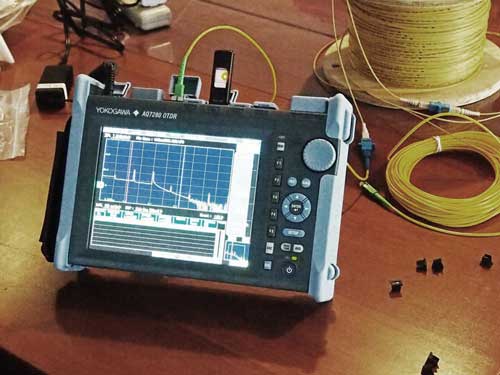
This
Yokogawa AQ7275 OTDR S/N C3RL18030F was stolen from the FOA in Santa Monica around July 26-27. Since the thief probably doesn't know what it is, it may show up on eBay or Craigslist or other online markets. If you have any information on this OTDR, contact the FOA at info@foa.org.
New FiberNext Job Board And Savings Club For CFOTs

FOA Approved School FiberNext has created an online job board for fiber techs and a special "savings club" for CFOTs.
Job Board
The Job Board was designed to help connect employers with fiber technicians and other fiber optic professionals. It is a place where employers in the fiber optic market can post job openings and a place where fiber optic professionals can post that they are looking for employment. Please feel free to post an opening or browse for your next job or employee. https://fibernext.com/job_board.php
Savings Club
FiberNext, besides being an FOA approved school is also a distributor. FiberNext invites FOA CFOT®s to join the “FiberNext CFOT® Club to get special savings on selected fiber optic products. Visit https://fibernext.com/cfot_club.php to sign up today ”
Recycling Fiber Optic Cable
We received this note from Steve Maginnis, LD4Recycle/ CommuniCom Recycling on recycling fiber optic cable:We have 3 Processors gearing up to accept fiber optic cable (FOC). As we all know, all FOC is not the same. Several truckloads of “typical” FOC scrap from FOC mfgrs and “typical” FOC and Coax cable have been studied and tested.
Therefore, today you can begin contacting me with the type FOC material or scrap you toss to the landfills today. We need to quantify the expected feedstock. Our expectation for quantities is quite large (tons) but there is a capacity limit. And I do have several processors that can take ALL materials and others that can accept LIMITED types of FOC material and quantity.
Contact:
Steve Maginnis
LD4Recycle/ CommuniCom Recycling
(Visit our new website)
sm@LD4Recycle.com
803.371.5436
Safety On The Job
Safety is the most important part of any job. Installers need to understand the safety issues to be safe. An excellent guide to analyzing job hazards is from OSHA, the US Occupational Safety and Health Administration. Here is a link to their guide for job hazard analysis.
Investigators Eye Fiber Optic Work in Deadly Wisconsin Gas Explosion
Firefighter killed, nine injured, and three buildings destroyed in downtown Sun Prairie, Wis.A hole punched into a 4-in.-dia gas pipeline during fiber-optic line laying is blamed for an explosion that killed a 34-year-old fire captain and injured nine other people, including four firefighters, in downtown Sun Prairie, Wis., on July 10. The injured were treated at nearby hospitals and have since been released. The blast destroyed three buildings, including the Barr House, a tavern at 100 Main St. that was owned by the deceased fire captain, Cory Barr.
Sun Prairie Fire Chief Chris Garrison said at a news conference that after the leak was initially reported at 6:20 PM CDT, first responders established a 300-ft-dia "hot zone" in the area and evacuated about 65 people before the explosion occurred. "The rapid response of firefighters, EMS and police saved a lot of lives," Garrison said. "This could have been a lot more tragic than it was."
The owner of the fiber-optics network is Verizon Wireless, which confirmed in a statement that it had contracted with Bear Communications "to provide a fiber backhaul for our networks." It added that no Verizon employees were present at the job site. "Verizon does contract with local providers in various markets to provide fiber backhaul for our networks," the Verizon statement said. "While we have not been contacted about the investigation, both we and Bear are prepared to work with law enforcement, public safety and public officials as they investigate this tragic situation."
Read the story in ENR. And the final report by the NTSB details the mistakes made by the contractor.
FOA also has lots of information on safety: FOA Guide, YouTube video and a Safety Poster
Best Practices Guide For Underground Construction
We assume you are familiar with the "One Call" and "Call Before You Dig" (811) program, but are you also familiar with the people behind it - the Common Ground Alliance and their Best Practices website?
CGA is a member-driven association of 1,700 individuals, organizations and sponsors in every facet of the underground utility industry. Established in 2000, CGA is committed to saving lives and preventing damage to underground infrastructure by promoting effective damage prevention practices. CGA has established itself as the leading organization in an effort to reduce damages to underground facilities in North America through shared responsibility among all stakeholders.
Officially formed in 2000, the CGA represents a continuation of the damage prevention efforts embodied by the Common Ground Study. Sponsored by the U.S. Department of Transportation and completed in 1999, this Study represents the collaborative work of 160 industry professionals who identified best practices relating to damage prevention.
Any best practice or program endorsed by the CGA comes with consensus support from experts representing the following stakeholder groups: Excavators, Locators, Road Builders, Electric, Telecommunications, Oil, Gas Distribution, Gas Transmission, Railroad, One Call, Public Works, Equipment Manufacturing, State Regulators, Insurance, Emergency Services and Engineering/Design.Read the CGA Best Practices Guide here.
Here are all the CGA resources for damage prevention.
Should Your Company Become An FOA Corporate Member?
A Short (Pictorial) History Of Modern Telecommunications
FOA has been asked a lot of questions about how modern telecommunications developed. We've been adding information about the history to some of our seminars and recently to our curriculum presentations. The FOA history follows the development of modern communications through Bell, Marconi, De Forest, Shannon, Kao and the personnel at Corning and Bell Labs who have made modern communications possible.
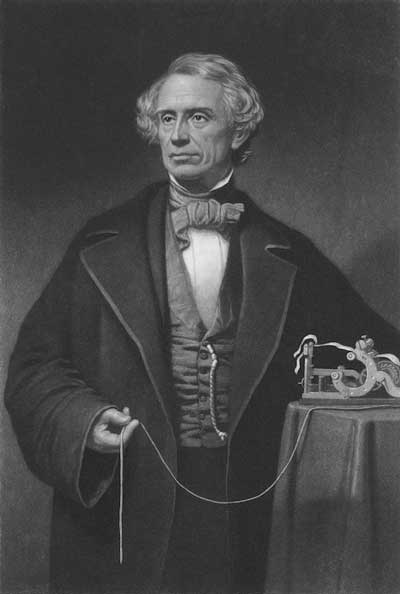 Morse and his telegraph
Morse and his telegraph
We think you will find A Short History of Modern Telecommunications interesting. Next we'll add articles on LANs and structured cabling and the development of fiber optics.
Trivia for photographers: this photo of Morse was taken not long after photography began in America - the early 1840s. The original is now on display in the Getty Center in LA as part of an exhibition of early American photographs.
FOA Facts
FOA is a non-profit professional society whose members are all certified techs - mostly CFOT®s -Certified Fiber Optic Technicians - but also may be CPCTs - Certified Premises Cabling Technicians or corporate members involved in fiber optics.
FOA is a "virtual organization" - we have no "brick and mortar" presence. We operate over the Internet with operations centered in California, with active workers and volunteers in locations as diverse as Texas, Ohio, Canada, Singapore, Malaysia, Denmark, South Africa, the Middle East and many more.
Being a virtual organization, FOA has very low overhead, allowing us to offer cost-effective certifications and many free programs to support our industry.
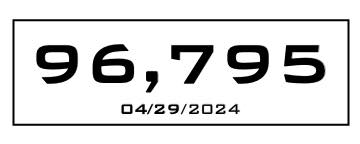
As of today, FOA has certified this many techs. About 90% come from our schools but many experienced techs have become FOA CFOT-certified directly through our ["Work-to-Cert"](Certs.htm#direct "FOA "Work-To-Cert" Certification Program") program.
FOA has almost 200 approved training organizations in about 40 countries around the world around the world.
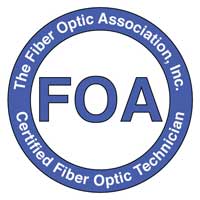
FOA has 14 fiber optic certification programs covering every aspect of fiber optic network design, installation and operation.
Primary Certifications: CFOT (basic fiber), CPCT (premises cabling), CFOS/O (outside plant, taught with CFOT included) and CFOS/D (fiber optic network design).
Skills Certifications (for installers and techs, requires CFOT): CFOS/S (splicing), CFOS/C (connectors/termination), CFOS/T (testing), CFOS/FC (fiber characterization).
Applications Certifications (for techs or anyone, including managers and supervisors): FTTH (fiber to the home), CFOS/L (optical LANs), CFOS/DC (data centers), CFOS/A (fiber to the antenna), CFOS/DAS (distributed antenna systems) and CFOS/W (fiber for wireless)
 FOA monitors the trade press, websites and other resources continually to look at what's happening in many technologies that affect fiber optics. We're tracing technologies as diverse as wireless, IoT, autonomous vehicles, smart cities, energy, or anywhere fiber is used to bring news to our readers.
FOA monitors the trade press, websites and other resources continually to look at what's happening in many technologies that affect fiber optics. We're tracing technologies as diverse as wireless, IoT, autonomous vehicles, smart cities, energy, or anywhere fiber is used to bring news to our readers.
FOA continually updates our technical materials, online and printed, and our curriculum to ensure our readers have access to the latest technical information and our schools teach the latest technology and applications. Our printed books are being updated right now.
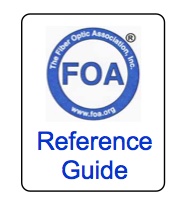
FOA created the FOA Online Guide as a non-commercial trustworthy technical reference almost a decade ago so the industry would have a reliable technical reference. In the last year, over 1million visitors downloaded about 4 million pages of technical information.
FOA offers free online self-study programs at Fiber U. In 2017, the number of online sessions doubled to 200,000. Many of those are preparing for FOA certification programs - taking courses at our schools or using the ["Work-to-Cert"](Certs.htm#direct "FOA "Work-To-Cert" Certification Program") program. Some of our schools are requiring Fiber U programs as prerequisites for their classroom courses so they can spend more time on hands-on activities.
 FOA offers over 100 educational YouTube videos that have been viewed 2.4 million times.
FOA offers over 100 educational YouTube videos that have been viewed 2.4 million times.
FOA offers its training programs to other organizations at no cost to help them train their members properly in fiber optics. For example, FOA has been working with the Electrical Training Alliance (IBEW/NECA) for over 20 years, training their instructors for their apprenticeship programs. We work with many other organizations and companies to provide the materials they need.
FOA has about 300 corporate members - companies in various aspects of the fiber optic industry worldwide that we list online and offer discounts on certifications and renewals.
FOA provides speakers for many conferences and even presentations for use by other organizations to educate people on the aspects of fiber optic communications.
FOA has a program to provide
classroom materials for STEM teachers (science, technology, engineering and math) introducing K-12 students to fiber optics and creating science projects.
FOA provides forums for discussion on various social media. Our LinkedIn groups have about 5,000 members each. If you are not joining us on social media yet, please do.
New From FOA
Keeping Up To Date
FOA believes that tech information must be kept up to date, so we are often updating our books. Along with the changes we make to the books, we update the FOA Guide with the same materials. Here is a rundown of the 2018 updates of The FOA Reference Guide To Fiber Optics, The FOA Reference Guide To Outside Plant Fiber Optics and_The FOA Reference Guide To Premises Cabling_.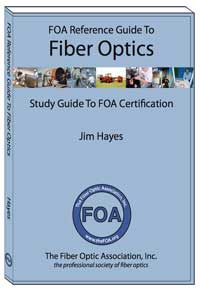
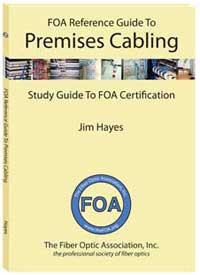
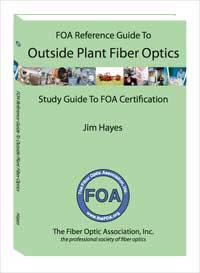
The FOA Reference Guide To Fiber Optics has been updated to cover some new technology like bend-insensitive fiber, OM5 fiber, SOCs (fusion splice-on connectors), microcables and microducts. We added information on datalinks on a single fiber like PONs, DWDM and CWDM. We expanded the chapter on testing to include much more information on visual inspection and connector cleaning, OTDRs and Fiber Characterization. The same updates have been made to the online material in Fiber Optics - The Basics in the FOA Guide online
Premises cabling has not been standing still either. We did many updates to the The FOA Reference Guide To Premises Cabling this time. We updated the cable types to include Cat 8, added a section on PoE (power over Ethernet), explained the nomenclature used in the latest TIA 568 standards, added information on POLs (passive optical LANs), DAS (distributed antenna systems for cellular) and a complete new Appendix on Data Centers. In the fiber optic chapter, we expanded the material on fiber to include POLs, visual inspection and connector cleaning and OTDR testing. The same updates have been made to the online material in Premises Cabling in the FOA Guide online. We also added a new page just on PoE (Power over Ethernet) to explain its background, applications and potential issues.
We have also updated the FOA Reference Guide To Outside Plant FIber Optics. It
has been updated to cover some new technology like bend-insensitive fiber, OM5 fiber, SOCs (fusion splice-on connectors), microcables and microducts. We added information on datalinks on a single fiber like PONs, DWDM and CWDM. We expanded the chapter on testing to include much more information on visual inspection and connector cleaning, OTDRs and Fiber Characterization.
So if you look up information on the FOA Guide online or purchase a FOA printed textbook you will now have the latest information. Since we've been updating our reference materials used for training, the related courses on Fiber U are updated also. Finally, we're updating our curriculum used by FOA approved schools to ensure their students get the latest information.
This is just another way that FOA tries to make the most up-to-date, technically correct information available to everyone in the industry.
Have You Downloaded Your Copy Of The Updated ANSI/NECA/FOA Fiber Optic Installation Standard Yet?
Available Free Courtesy of FOA
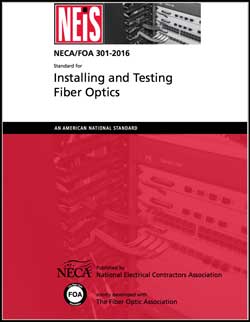
NECA/FOA-301was created to be a document that could be used as a guide to installation practices and also be quoted in project paperwork to define what was meant by installation in a "neat and workmanlike manner." This standard was the first standard to approach the issues of installation of fiber optics in a document that could be used by network owners, project managers, contractors, installers, test techs, maintenance personnel and even the manufacturers making the products being installed following this standard.
Go here for more information on NECA/FOA-301 and directions for a free download.
FOA's Newest Textbook - Fiber Optic Testing
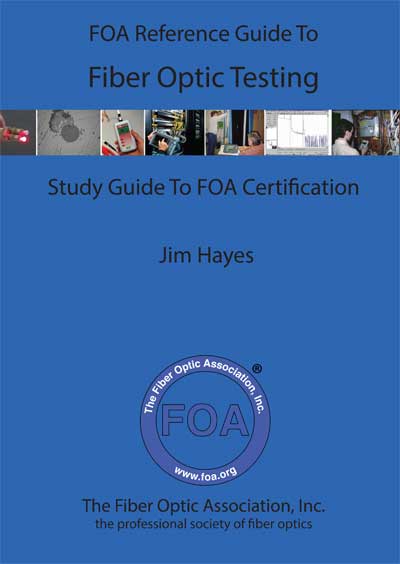 FOA Reference Guide To Fiber Optic Testing
FOA Reference Guide To Fiber Optic Testing
Libro de Diseño para Redes de Fibra Óptica en Español - FOA Design Book Available In Spanish - Online
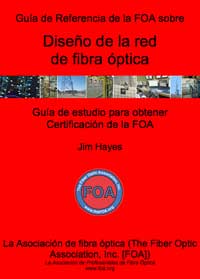
La Asociación Profesional de Fibra Óptica (The FOA) ha traducido y hecho disponible en Español, la “Guía de Diseño para Fibra Óptica”. Esto para todos los interesados en estudiar para la certificación CFOS/D en su idioma nativo. Puede acceder a la traducción al libro de Diseño en línea utilizando este enlace. La versión impresa del libro estará disponible muy prontamente.
FOA has translated the FOA Guide To Fiber Optic Network Design book and made it available online to those studying for the CFOS/D Certification but whose native language is Spanish. You can access the Spanish translation of the Design book here. A printed version will be available in the near future.
Interested In A Career In Fiber Optics?
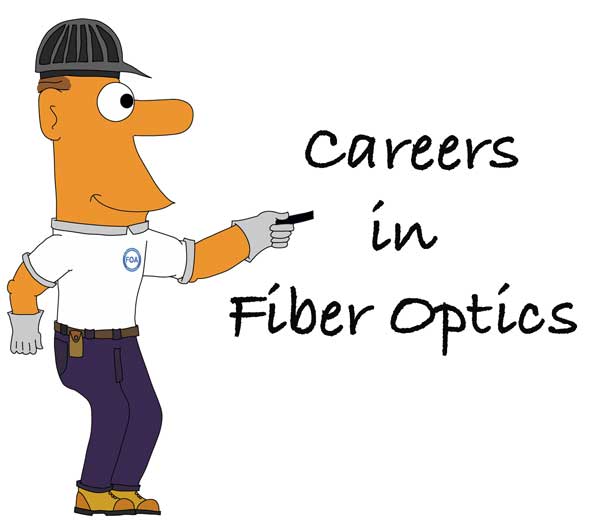
FOA has created a new YouTube video to introduce students to careers in fiber optics. It was made for showing to high school and junior high students interested in tech careers but anyone interested in a possible career in this field will find it interesting. If you have kids in school or know teachers, let them know about this too. Watch the FOA Careers In Fiber Optics Video on YouTube and visit the FOA Careers In Fiber Optics web page at www.foa.org/careers/.

The word on the "Dig Once" program is getting out - FOA is getting calls from cities asking us for information and advice. It helps that the current Administration is trying to convince cities of the advantages of installing ducts or conduits when they dig up a street so they don't have to do it again. Here are some links for more information.
The DoT page on the administration’s Executive Order: http://www.fhwa.dot.gov/policy/otps/exeorder.cfm
From the Council of State governments: http://www.csg.org/pubs/capitolideas/enews/cs41_1.aspx
From the city of San Francisco: http://sfgov.org/dt/dig-once
An article about Dakota County, MN: https://muninetworks.org/tags/tags/dig-once
And the one to download and hand out:
A “How To” Guide from The Global Connect Initiative: https://share.america.gov/wp-content/uploads/2016/04/6.-GCI-Dig-Once.pdf
Useful Online Resources
We often have contacts give us online links for useful information which we like to share with our readers. Here are two:
Why We Warn You To Be Careful About Fiber Shards
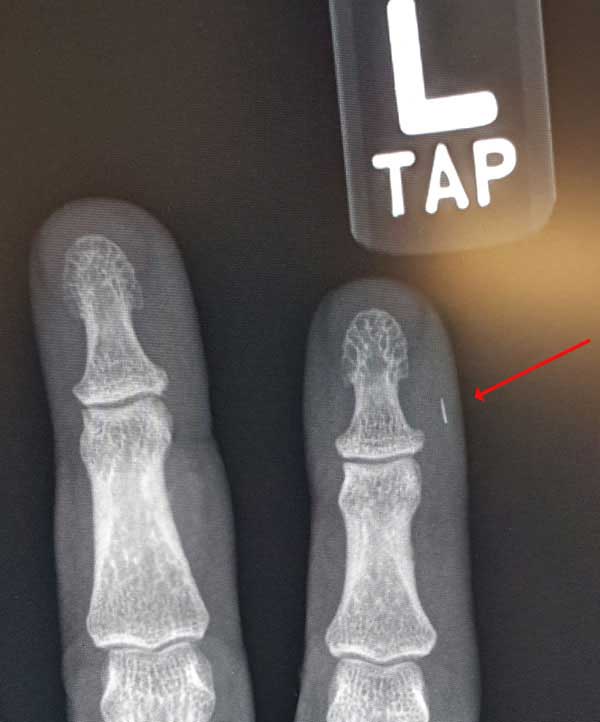
Photo courtesy Brian Brandstetter, Mississauga Training Consultants
1-844-440-0047
www.fiberoptictraining.com
Another Source Of Articles On Fiber
FOA President and editor of this newsletter Jim Hayes has also been writing a column in Electrical Contractor Magazine for more than 15 years now. Electrical contractors do lots of fiber work and this column has covered some toics they are interested in including installation processes, network design, fiber applications and in the last year, a lengthy series on dark fiber - what it is, how's its used and how it benefits the growth of communication. A recent web site redesign makes it easier to browse all these articles - just go to http://www.ecmag.com/contributing-authors/jim-hayes and you can see all of them.
Fiber Optic Education For Students At Any Age
We hear about fiber optics all the time - it's in the news whenever we hear articles about high tech, the Internet and communications, and many communities are getting "fiber to the home." But few people really understand fiber optics or how it works. FOA is focused on educating the workforce that installs and operates these fiber optic networks but we're always getting inquiries from STEM (science, technology, engineering and math) teachers who want to introduce fiber optics to younger students in K-12 grades or technical schools.
We start with the FOA Careers In Fiber Optics Video on YouTube and visit the FOA Careers In Fiber Optics web page at www.foa.org/careers/. These are for students who think they might be interested in careers in fiber optics and want to know more about what fiber techs do.
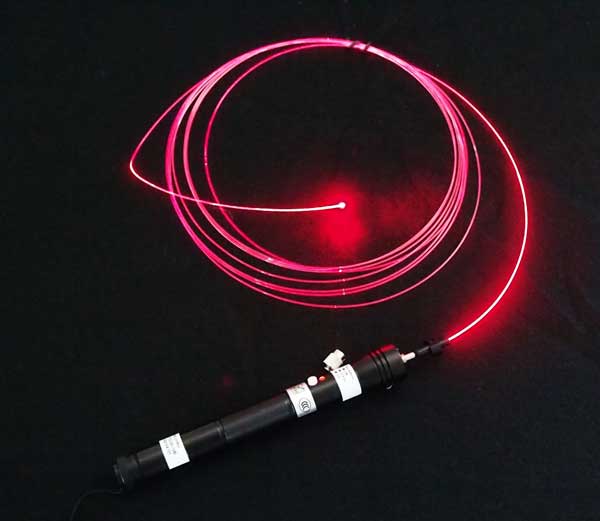
Using red laser light (a VFL here but a laser pointer works also) to show how fiber guides light.
FOA has begun developing a series of YouTube videos intended for teaching students in elementary, middle and high schools about fiber optics. The first FOA video is titled "Fiber Optics For Teachers." With this video, we show teachers how fiber works and carries signals and then explains simple experiments to demonstrate how fiber optics works in the classroom using some plastic fiber and a laser pointer. Since many teachers do not know where to get the fiber, the FOA offers to send them a sample for use in demonstrations in their classroom (USA only right now.)
At the end of the video, teachers are given directions on how to request samples of the plastic fiber from the FOA.
This video joins the "Fiber Optics Live" series How Light Travels In A Fiber, Fiber Attenuation and Connector Loss that show how fiber works using simple experiments that can be duplicated in any classroom. More videos will be coming soon.
If you have kids or know some teachers who would be interested, please send them to the introductory video Fiber Optics For Teachers and we'll be glad to help them get started with some entertaining programs for their classrooms.
Resources For Teachers In K-12 And Technical Schools
Teachers in all grades can introduce their students to fiber optic technology with some simple demonstrations. FOA has created a page for STEM or STEAM (science, technology, engineering, arts and math) teachers with materials appropriate to their classes. Fiber Optic Resources For Teachers.
If you have kids in school or know teachers who are interested, send them to the FOA page Fiber Optic Resources For Teachers.
Should Your Company Become An FOA Corporate Member?
As all FOAindividualmembers know, they join the FOA by becoming certified, mostly taking their CFOTs but some CPCTs, either by attending a FOA approved school or joining directly based on field experience (our "work to cert" program.) Over the years, we've been contacted by manufacturers, contractors, consultants, and other types of organizations who ask about becoming members.
We don't certify companies or organizations, we told them, so we were not sure what we could offer as a benefit of membership. But then, companies asked about using our educational programs to train employees, how they could get listed on the FOA website as service providers or if they could get a quantity discount on membership or certification for all the FOA members working for them. That began to sound like a benefit for being an FOA corporate member. And providing a list of useful suppliers to the market could be a benefit to the industry as a whole.
So FOA has quietly been letting companies and other organizations join the FOA to take advantage of those benefits so we now have several hundred corporate members. We've put then into a database and listed them on the FOA website in map and list form. Here's the map.
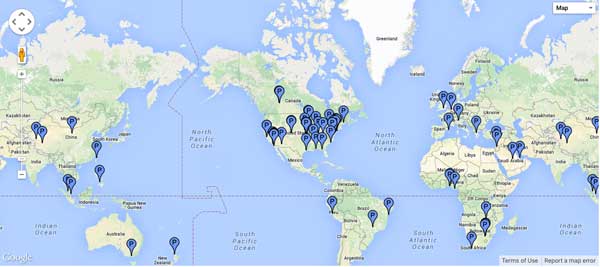
The online
map and list can be used to find suppliers and service providers. The map, like our map of schools, lets you find the FOA corporate members close to you. The table form lists them by category: Installer/Contractor, Component Manufacturer, Installation Equip. Manufacturer, Transmission Equipment, Services/Consulting, Distribution and Users of Fiber Optic Networks. You can sort the tables to find members meeting your needs, e.g. by location, certifications offered, etc. Click on any column heading to sort that column; click twice to sort in reverse order.
How Does An Organization Become An FOA Corporate Member?
Simple, just fill in the online application form. When your application is accepted, you will be asked to pay the membership fee - 100USfirstyear,100US first year, 100USfirstyear,50US/year or $100US/3years to renew. You will then be listed on the online map and list, have access to exclusive FOA educational materials for your employees and get discounts on certifications and renewals.
Events of Interest: FOA now posts events on our LinkedIn groups, Facebook page and other social media

FOA has a company page and three LinkedIn Groups
FOA - official company page on LinkedIn
FOA - covers FOA, technology and jobs in the fiber optic marketplace
FOA Fiber Optic Training - open to all, covers fiber optic technology and training topics
Grupo de La Asociación de Fibra Óptica FOA (Español)
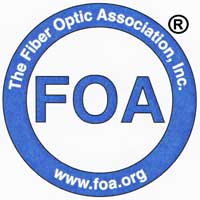 What's Happening @ FOA
What's Happening @ FOA
FOA Standards:
FOA offers free standards for datalinks and testing the installed fiber optic cable plant, patchcords and cable, optical power from transmitters or at receivers and OTDR testing. Look for the "1 PageStandard" web page and in the FOA Online Reference Guide.
View the FOA YouTube Video On FOA Standards
NECA/FOA 301 Fiber Optic Installation Standard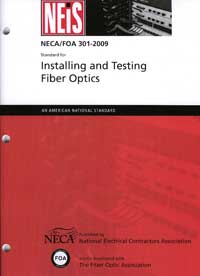
Standards cover components and systems and how to test them, but rarely get into installation issues. The FOA NECA 301 standard which covers installation of optical fiber systems has been revised for the second time, adding considerable new materials. This standard is derived from FOA educational material put in standards form and approved by ANSI as an American National Standard. It's specifically written to be used in contracts to define "installation in a neat and workmanlike manner." The standard is available from NECA. FOA members can go here for instructions on how to download your free copy.

Free Fiber U Self-Study Programs
FOA's "Fiber U" free online self-study programs help you learn about fiber optics, study for FOA certifications or use them to help create "blended learning" classes. There are two new free online self-study programs on Fiber U. Fiber Optic Network Design is for those interested in learning more about how to design fiber optic networks or studying for the CFOS/D certification. FTTx is for those wanting to know more about fiber to the "x" - curb, home, wireless, etc. - or studying for the CFOS/H certification.
Got to Fiber U for more information.
Fiber U Online Self-Study Programs Offer Certificates of Completion
FOA has been offering quite a few free online self-study programs on Fiber U, our online learning site. We are always getting questions about getting a certificate for completing the course online, so we have setup an option to take a test online and get a certificate of completion for these online courses.
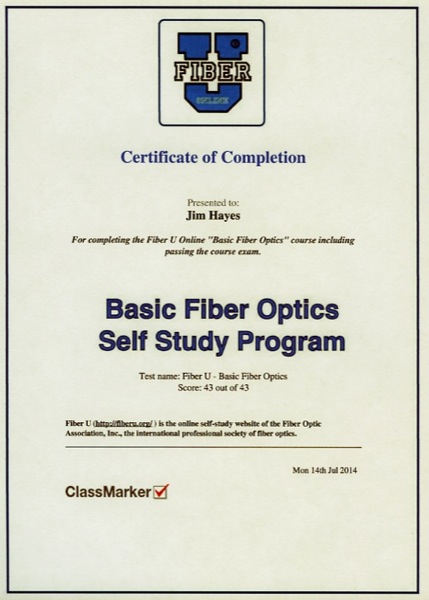
While it's not FOA certification, FOA will recognize a
Fiber U Certificate of Completion as background experience to qualify for applying for FOA certifications. We also intend to expand the program to more specialized topics as preparation for FOA specialist certifications.If you have associates that want to get started in fiber, have them take this course online to get started. Go to Fiber U and get started.
FOA Books And Publications
 FOA Reference Guide To Fiber Optic Testing
FOA Reference Guide To Fiber Optic Testing
FOA Basic Fiber Optic Textbook Now Also Available in French and Spanish
FOA Reference Guide To Fiber Optic Network Design And FOA's Outside Plant Fiber Optic Construction Guide
Read More about the FOA Reference Guide To Fiber Optic Network Design andMore information on the FOA Outside Plant Fiber Optics Construction Guide
Lennie & Uncle Ted Guides - Perfect For Getting Started
Lennie and Uncle Ted's Guides have moved to the FOA website. Lennie is the place where many if not most fiber techs begin their education. FOA has just updated the two guides to ensure they stay relevant - more than 20 years after they were first written.
Lennie goes all the way back to 1993 when he was created as the mascot of the original "Fiber U" conference - the same Fiber U that is now the FOA's web-based training site. Lennie Lightwave's Guide To Fiber Optics was created as a beginner's introduction to fiber optics. Over 60,000 printed version of Lennie's Guide were given away and it became one of the first commercial web pages in 1994. Uncle Ted's Guide To Communications Cabling was written a few years later to introduce techs to "Cat 5" - UTP wiring - that had only recently been standardized in TIA-568.
Lennie and Ted's Guides are used in the current Fiber U online self-study programs and are still the best place to start learning about fiber optics.
Lennie and Uncle Ted's Guides are online at the links here, can be downloaded as printable PDFs and are now also available as free iBooks on iTunes.
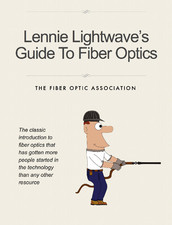
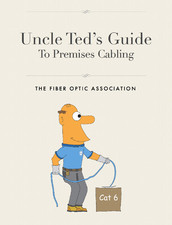
Lennie Lightwave's Guide to Fiber Optics and Uncle Ted's Guide To Communications Cabling are now available free to iPad users who can download them from the Apple iTunes store. Of course they are still available online or for download.
You can also find these free guides on the FOA website - go here for all the links: Lennie Lightwave's Guide to Fiber Optics and Uncle Ted's Guide To Communications Cabling Download PDFs of Lennie or Uncle Ted.
FOA iPad Apps
FOA LossCalc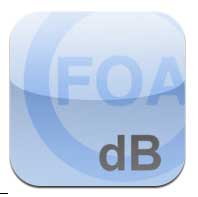 FOA LossCalc estimates the optical loss of a fiber optic link. This will save time for the installer of a fiber optic link needing to know whether test results are reasonable and/or make a "pass/fail" determination. It can also help the designer of a link to determine if communications equipment will operate over this link.
FOA LossCalc estimates the optical loss of a fiber optic link. This will save time for the installer of a fiber optic link needing to know whether test results are reasonable and/or make a "pass/fail" determination. It can also help the designer of a link to determine if communications equipment will operate over this link.
By choosing the type of link (singlemode or multimode) and specifying the length of the fiber and numbers of connections and splices, it will calculate the end to end loss of the link. The app has default specifications for singlemode and multimode links or the user may create custom setups with specifications appropriate for any application. http://itunes.apple.com/us/app/foa-losscalc/id476262894?mt=8&ls=1
Self -Study in Fiber Optics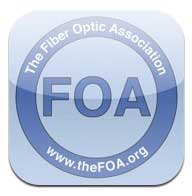 Our first app is a self-study version of the FOA Reference Guide to Fiber Optics. The FOA APP builds on the FOA basic fiber optic textbook to create an interactive learning environment that builds on the iBook electronic version of the book to add a guide to use for self-study and real-time testing that provides feedback on what you have learned and correct answers to questions answered incorrectly.
Our first app is a self-study version of the FOA Reference Guide to Fiber Optics. The FOA APP builds on the FOA basic fiber optic textbook to create an interactive learning environment that builds on the iBook electronic version of the book to add a guide to use for self-study and real-time testing that provides feedback on what you have learned and correct answers to questions answered incorrectly.
The FOA APP is priced at only $9.99, same as the iBook, so the self-study program is free. Download it from the Apple APP Store with your iPad or iTunes.
http://itunes.apple.com/us/app/foa-guide/id434354283?mt=8&ign-mpt=uo%3D4

The FOA has many videos on  , including two Lecture Series (Fiber Optics and Premises Cabling), Hands-On lectures on both and some other informational and instructional videos. For all the videos, go to the FOA Channel "thefoainc" or use the direct links below.
, including two Lecture Series (Fiber Optics and Premises Cabling), Hands-On lectures on both and some other informational and instructional videos. For all the videos, go to the FOA Channel "thefoainc" or use the direct links below.
View a complete list of FOA Videos with links to each video on YouTube.
Where Are The Jobs In Fiber Optics? FOA talks about all the applications for fiber optics, what jobs involve and the qualifications for the workers in the field.
Fiber Optics - Live! A series of videos that use lab demonstrations to show how optical fiber works.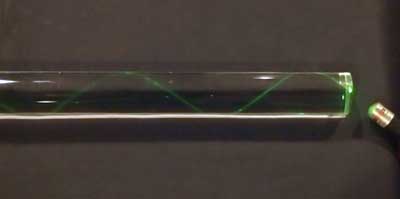
Cabling Project Management - what's involved in a copper/fiber/wireless project -advice for the customer and the contractor
Hazards Of Counterfeit Cable
You may have read the stories we have written about the counterfeit "Cat 5" cable made from copper-clad aluminum rather than pure copper. Recently we tried an unscientific burn test on the cable compared to a known good UL tested cable and posted a video on YouTube. You can see the results below.
Counterfeit Cable Real UL-rated cable
The difference is obvious and the danger is real. Watch the video on YouTube: Premises Cabling Lecture 11: Counterfeit Cat 5 Cabling
View a complete list of FOA Videos with links to each video on YouTube.
View all the FOA Channel on YouTube.

What's New in the FOA Online Fiber Optic Reference Guide?
We are continually updating the Online Reference Guide to keep up with changes in the industry and adding lots of new pages of technical information. Go to the FOA Guide Table of Contents to see the latest updates - look for  .
.
Find What You Want Using "Google Custom Search There's so much information on the FOA Tech Topics and Online Fiber Optic Reference Guide that even a well-organized Table of Contents isn't enough and when the material is always changing, an index is impossible to maintain. So the FOA is using the latest technology in search, Google Custom Search, which will allow you to search just the FOA Tech Topics and Online Fiber Optic Reference Guide for any topic you want to find more about. Try it!
There's so much information on the FOA Tech Topics and Online Fiber Optic Reference Guide that even a well-organized Table of Contents isn't enough and when the material is always changing, an index is impossible to maintain. So the FOA is using the latest technology in search, Google Custom Search, which will allow you to search just the FOA Tech Topics and Online Fiber Optic Reference Guide for any topic you want to find more about. Try it!
Go to The FOA Online Fiber Optic Reference Guide.
FOA Schools
Find a listing of all the FOA-Approved schools here.
Find An FOA-Approved Training Organization
Most inquiries we get regarding finding a FOA-Approved training organization want to know two things: what school is closest to me or what school offers the certifications I need. The FOA has about 200 training organizations we have approved worldwide so finding the right one can be difficult! We've been looking at ways to make it easier, and we think we've got a good solution. In fact we have two solutions.
First we have added a sortable table of all the FOA-Approved schools.
You can also use our FOA Google Map to find FOA-Approved schools.
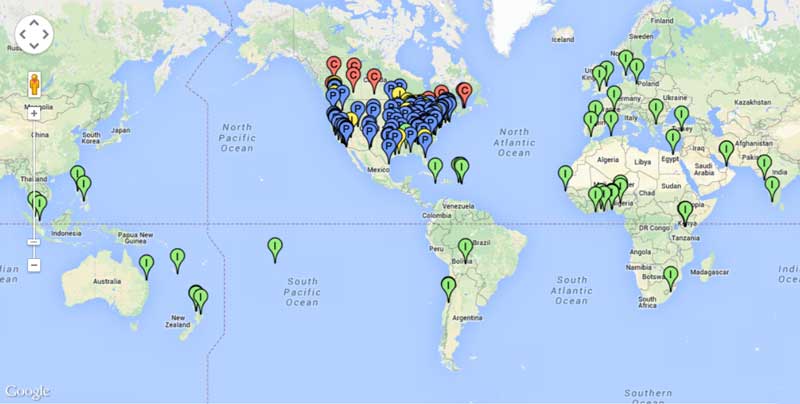
What Should A Fiber Optics or Cabling Tech Know and What Skills Do They Need?
FOA certifications are based on our KSAs - the Knowledge, Skills and Abilities that techs need to succeed. Read the FOA KSAs for fiber and cabling techs.
School News
Feedback
We always enjoy feedback, especially when it shows how great some FOA instructors are. These came from students of Tom Rauch, an instructor at BDI Datalynk:
"I took your fiber optics certification courses this past March. I just wanted to let you know that in two weeks I start working as a fiber optic technician with ___ up in ___. You mentioned on the first day of the course that there is always one guy in class who had rubbed his last two nickels together to be there and, in that instance, I was that guy. Now I'm going to be able to provide for my family like never before and I owe it to the certification that I received from you and BDI Datalynk. I just wanted to thank you again."
"Thanks to our tremendously knowledgeable and patient instructor Thomas Rauch, who was not only generous in sharing his wealth of information, but he did so with ease, humor and in a way that invited curiosity and participation. He was encouraging and proud of our accomplishments and helped us learn from our mistakes in a way that did not break our confidence, rather it pushed us to better results the next go around. The hands on labs were just AWESOME!" Just thought you should know what a class act you have representing you in his travels..... but then again you probably already knew that! : )
In almost 19 years at Verizon and having held numerous positions, I have gone through many training sessions. I cannot remember ever having been actually looking forward to coming back to class quickly after lunch, to get back to the hands on activities, and walking away with the sense of empowerment that the information presented was not only relevant but dead on point accurate! I will be signing up for the Outside Plant class on March! I can't say enough good things about Tom and his impact! Feel free to quote me, I can only imagine that he will open so many doors and change so many lives in the years to come, with his style of teaching! Great experience, awesome job!
"
IBEW and FOA Partner on Fiber Optic Training
The International Brotherhood of Electrical Workers (IBEW) and the National Electrical Contractors Association(NECA) through the National Joint Apprenticeship and Training Committee (NJATC) in a partnership with the FOA has published a new textbook for training IBEW apprentices and journeymen in fiber optics. The new textbook uses the material from the FOA Reference Guide To Fiber Optics with new material and photos from other NJATC training partners.

Quote from one of our certified instructors: I want to thank you and your organization for all the resources you provide for the students and the opportunity to offer the certification to the students. The fact that you published the book yourself to get the cost down and the unlimited free resources on your website shows a commitment to the public that is second to none. I let it be known to the students that the FOA is the best in the industry at supplying knowledge and resources related to the communication industry. I look forward to passing on the information that you provide for the industry.
Good Question! Tech Questions/Comments Worth Repeating
New: The FOA Fiber FAQs Page (FAQ s = frequently asked questions) gathers up questions readers have asked us and adds tech topics of general interest.
Real Questions From FOA Newsletter ReadersCleaning Connector Protective Caps
**Q:**How do you clean LC Fiber Optic end caps (the cap that covers the cleaned fiber cable)? Is there a tool for that?
A: We assume you are talking about the small plastic protective caps on the connector ferrule. There is a joke in the industry that goes “there’s a reason they call them "dust caps’” they’re often full of dust.” The problem is these are plastic molded parts that are made by the billions for various purposes - some just fit fiber optic connectors. They come out of the molding machine and are dumped in barrels. No provision is made to keep them clean, plus they will have some mold release chemicals inside them that can attract or hold dust. Even static electricity is a problem.
We know no way to clean them nor to keep them clean. We recommend using them to protect the connector ferrule - in fact we’re trying to get people to call them “protective caps” - but after they are removed and before use (connecting to another cable or a transceiver or testing them) they need inspection and cleaning.
See these pages in the FOA Guide: Microscope Inspection And Cleaning of Fiber Optic Connectors Cleaning Fiber Optic Connections
Directional Splice Loss
Q: I have a customer that is splicing a fiber distribution hub to their fiber plant. The fiber distribution hub utilizes 100FT long fiber stubs of SMF G.657.A1 and the fiber plant uses SMF G.654.D. The project has a contract fusion splice passing spec of 0.2dB loss, averaged bi-directional and also a one-way <0.3dB loss (either direction) specification; using an OTDR for measurements.
From my research, if the splices OTDR’s test results for the 2 directions are -0.2dB / +0.6 (average of +0.2), the network is not actually seeing a +0.6dB loss; but this is how the OTDR interprets the backscatter information… the OTDR being somewhat confused due to the bend insensitive fiber characteristics.
A: Correct - the directional differences are due to the mode field diameter variations in the two fibers. G.654 is a large MFD fiber, ~12.5microns, compared to ~9 microns for G.657.A fiber. The OTDR measures based on backscatter which will be very different for the two fibers.
Markers For Underground Fiber Optic Cables
Q: I have a general question about above ground markers for fiber optic cable in conduit. Is there a recommended spacing for the markers? Is there a standard to reference for this?
A: We asked some people who make them and they said the guideline is “line of sight.” The rules for markers are mainly what information needs to be on them. Of course we also recommend adding marker tape about a foot above the conduit. I was curious if there were any legal issues and I found this interesting page from Cornell Law School: https://www.law.cornell.edu/cfr/text/49/192.707
So I might add to line of sight any crossings of roadways, rail ways and some markers for bridge crossings.
We have a new section on the FOA Guide: Outside Plant Fiber Optic Cable Plant Construction that may be useful.
Reflectance And Return Loss
Q: Help me understand measuring reflection little better. Why do we consider -55dB to be a better reading than, say, -25dB? If reflection and return loss are inverse readings and we had a 55dB return loss, would that positive reading for return loss be considered good?
A: Reflectance is measured as the ratio of reflected to incoming signal at a connection. The confusion comes because reflectance and return loss are inverse readings. Consider this:
If we have 1/1000 of the light reflected, the reflectance would be -30 dB (1/1000 = -30 dB) but the return loss would be 30dB since it is defined as 1000/1, the inverse, and is described as +30 dB.
Likewise, an APC connector would have a reflectance of -50 dB or a return loss of 50 dB.
However, return loss as tested by all OTDRs is not be the reflection from a single event but the total of all reflectance events plus total backscatter from the length of fiber being tested in the trace.
This is where most people are confused and misuse the terms.
Older questions are now available here on the FOA Guide.
Worth Reading or Watching:
We are moving most of the articles in this section to the FOA's Pinterest Page "Worth Reading" - Go there for the latest links
Sign up at the FOA Pinterest board 
FOA "Quickstart Guides"
In our continuing quest to help people understand how to test fiber optic cable plants and communications systems, we've created two more "QuickStart Guides to Fiber Optic Testing." They are simple, step-by-step guides on how to test fiber optic cable plants, patchcords or single cables using insertion loss or OTDR techniques and optical power from transceivers. It's as straightforward as it can get - what equipment do you need, what are the procedures for testing, options in implementing the test, measurement errors and documenting the results.
It can't get much simpler.
Send anybody you know who needs to know about fiber optic testing here to learn how it's done in a few minutes.
Testing Fiber Optic Cable Plants And Patchcords
Testing Fiber Optic Cable Plants With An OTDR
Measuring Optical Power In Communications Systems
Like Crossword Puzzles? Here's Some On Fiber Optics
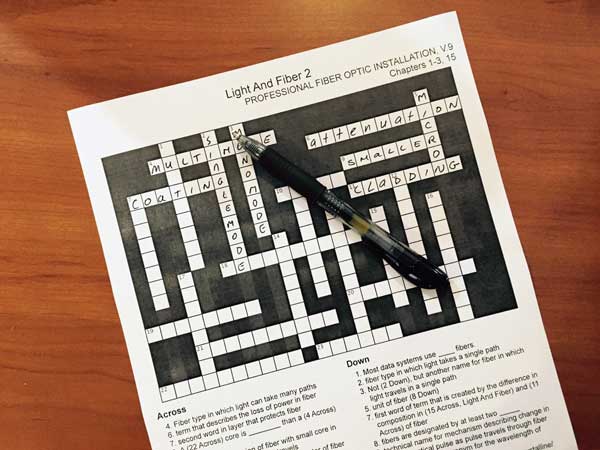
Do you like crossword puzzles? How about one on fiber optics - or maybe a half-dozen of them? FOA Master Instructor Eric Pearson of Pearson Technologies has created a series of crossword puzzles on fiber optics that are keyed to the FOA CFOT reference materials and his book Professional Fiber Optic Installation, v.9. You can have fun and study fiber optics at the same time!
This months crossword puzzle is on "Optoelectronics and Splicing" - Download the crossword puzzle on
"Optoelectronics and Splicing."
If you missed the earlier puzzles, here they are:
Download the PDF file of the crossword on "Light and Fiber".
Download the PDF file of the crossword puzzle on "Cables".
Download the crossword on "Connectors & Splices."
Older Fiber, Do You Know How Good It Is?
There's millions of miles of long distance fiber installed around the world and most of it likely to see an upgrade of the systems operating on it, probably in the near future. Twenty years ago, most of it was probably running at ~1Gb/s, ten years ago it was probably 2.5 Gb/s, recently it was likely to be 10Gb/s but now many are being considered for 100Gb/s or beyond. Can the fiber support such speeds? Can it be "repaired" or "modified" to make it possible to use it at higher speeds? If you own that fiber, can you say what it is worth without knowing its future upgrade capability.
In order to know the potential for upgrades on your cable plant, you need to test it. This process involves a number of tests and is called "fiber characterization." Greg Stearns of TTP-US, an FOA Corporate Member, performs these tests and has written a short article on why you need to characterize fiber and how its done. Read about fiber characterization from someone who does it often and can explain it well.
Download the paper here (PDF, 80kB).
Where In The US Do Contractors Need Licenses For Fiber Optics?
We often get asked where in the US do contractors doing fiber optic installations need licenses. We found a good website for that information, the NECA -NEIS website. You might remember NECA-EIS, as they are the partner with the FOA in the NECA/FOA 301 Fiber Optic Installation Standard. NECA is the National Electrical Contractors Association and NEIS stands for National Electrical Installation Standards. They have a very easy to use map and table that gives you data on every state in the US, so mark these pages for future reference.
NECA/NEIS
http://www.neca-neis.org (See “State Regulations”)
http://www.neca-neis.org/state/index.cfm?fa=state_regs (all electrical licensing)
Low Voltage: http://www.neca-neis.org/state/index.cfm?fa=specialty_licensing
Benchmarking Fusion Splicing And Selecting Singlemode Fiber
We've been asked many times "How long does it take to splice a cable?" It's not a simple answer as it varies with the number of fibers in the cable and the work setup, including whether one or two techs are working at a job site. FOA Master Instructor Joe Botha of Triple Play in South Africa did his own analysis based on decades of experience both splicing cables and teaching others how to do it properly. This is one of the best analyses we have seen because Joe includes prep times as well as splicing times and differentiates between one tech and two techs working together. He adds some other tips on fusion splicing too. This should be mandatory reading for every tech and given to every student! Here is Joe's splicing analysis.
Joe also has an excellent writeup on how to choose singlemode fiber that helps understanding the different types of G.6xx fiber. Read it here.
And you will want to read Joe's report on splicing different types of SM fiber, including bend-insensitive (G.657) fiber. Read it here.
Free - Mike Holt's Explanation Of The US National Electrical Code (NEC) For Communications Cables
Mike Holt is the acknowledged expert of the US National Electrical Code (NEC). His books and seminars are highly praised for their ability to make a very complicated standard (that is in fact Code - law - in most areas of the US) easily understood. Part of the appeal is Mike's great drawings that make understanding so much easier. Mike makes Chapter 8 of his book available free. It covers communications cables, telephones, LANs, CATV and CCTV, for premises applications. Even if you live in a region or country where the NEC is not the law, you may find this interesting.
Download Mike's Chapter Here.
Good Technical Website For Installers
American Polywater (http://www.polywater.com/) has one of the best technical website for cable installers. Check out their website, especially “Videos,” “Engineer’s Corner” and “Calculators.” http://www.polywater.com/NNNBSL.pdf
Fiber Optic Safety Poster
We've had numerous requests to reprint our guidelines on safety when working with fiber optics, so we have created a "Safety Poster" for you to print and post in your classroom, worksite, etc. We suggest giving a copy to every student and installer.
FOA Tech Topics -
A Fiber Optic Tester In Your Pocket? (See the video on  )
)
Yes! The camera in your old cell phone is sensitive to infrared light - lots more than your eye - and can detect light in an optical fiber or from a transmitter. Chris Hillyer,CFOT/CFOS/I, Master Instructor, Northern California Sound & Communication JATC brought this to our attention.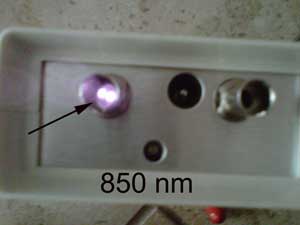

If you have an old cell phone, try it. Our experience is that older cell phone cameras have better sensitivity at IR wavelengths than newer phones, so you may want to toss that old flip phone into the toolbox.
Product News
YOKOGAWA OTDR Has Extended range, High Resolution And Multitasking
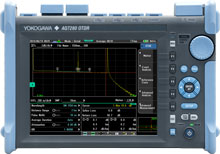
One OTDR manufacturer you don't hear as much about is YOKOGAWA (formerly ANDO) which is too bad - they make some of the best OTDRs, exemplified by this new model AQ7280. Need long range - how about 50dB. High resolution - 0.6m dead zone. Like touch screens, but for some functions want hard buttons, it's got that. Options for VFL, microscope, light source and power meter, etc. - it has that too.
But the unique aspect of the YOKOGAWA AQ7280 is it offers multitasking - you can let do a trace with long averages while you inspect connectors, make power readings, use the VFL or other functions.
More info on the YOKOGAWA AQ7280.
